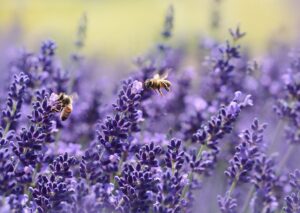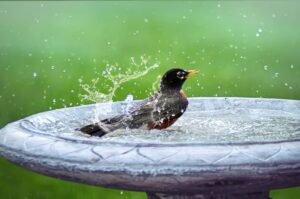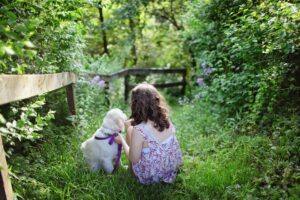Understanding pollinators and beneficial insects is essential for creating a vibrant garden. By recognising the vital role they play in plant reproduction and pest control, you can harness their power to transform your garden into a lush and colourful oasis. And by making good use of pollinators and beneficial insects, you’ll have a verdant and colourful garden in no time! To attract pollinators and beneficial insects, however, you need to know more about them.
Creating a pollinator-friendly garden is a delightful and impactful endeavor. To attract pollinators and beneficial insects and enhance biodiversity, start by selecting native plants that resonate with local pollinators. Opt for a diverse range of flower shapes and colours to entice various species. A continuous blooming season ensures a steady supply of nectar and pollen. Design your garden to include habitats that provide shelter and nesting sites for beneficial insects like bees and butterflies. Avoid using harmful pesticides that can deter pollinators and disrupt the garden ecosystem. Instead, you can always pick organic and natural pest control methods. Install water sources such as bird baths and shallow dishes to cater to their hydration needs. So, by making your garden a haven for pollinators, you’ll witness a harmonious dance of nature filled with beauty and abundance.

Designing habitats for beneficial insects is a strategic and rewarding aspect of gardening. So, introduce a diverse range of plant species to attract a variety of beneficial insects like ladybugs, lacewings, and hoverflies. Create a mix of flowers, herbs, and shrubs that provide food and shelter for these helpful garden allies. Moreover, incorporate mulch and natural debris as hiding spots and nesting areas. And avoid using harmful pesticides to maintain a safe environment for these beneficial insects. Finally, embrace companion planting to enhance their presence and boost their population. It’s essential to strike a balance between aesthetics and functionality while designing the habitat, too. So, keep the garden practical, such as accounting for garden tool storage and walkways.
Water sources are a crucial element to attract pollinators and beneficial insects. Birds, butterflies, and other beneficial insects require water for hydration and bathing. By incorporating bird baths, shallow dishes, or even a small water garden, you provide a valuable resource for these creatures. Ensure the water sources are easily accessible and kept clean to encourage frequent visits! A dripping water feature can attract a broader range of wildlife, too, including amphibians and reptiles.
Moreover, consider adding rocks or pebbles to create landing spots for butterflies and other insects. To maintain a balanced ecosystem, avoid using pesticides near the water sources. With a reliable water supply, your garden will flourish with diverse wildlife, adding charm and enchantment to your outdoor space.

Bees play a vital role in pollination, making them indispensable garden allies. As they forage for nectar and pollen, they transfer these tiny grains between flowers, fertilising them and enabling the formation of fruits and seeds. This process ensures the reproduction of numerous plant species, including many of our favorite fruits, vegetables, and flowers. Honeybees, bumblebees, and solitary bees are among the primary pollinators. Each bee species has distinct preferences, making a diverse selection of flowers essential to attract a variety of them. Bees are efficient and hardworking, visiting hundreds of flowers daily. However, bees face challenges such as habitat loss and pesticide exposure, contributing to declining populations. So, by providing a pollinator-friendly garden with a rich assortment of nectar-rich flowers, you can support these industrious insects and contribute to the preservation of our ecosystem.
Butterflies and moths are also essential pollinators, adding grace and beauty to our gardens while performing a crucial ecological role. As they flutter from flower to flower, they collect and transfer pollen, aiding in the reproduction of various plant species. Butterflies, with their vibrant colours and delicate wings, are primarily daytime pollinators, while moths, known for their nocturnal activities, take the night shift. To attract these enchanting insects, cultivate a diverse garden with colourful and nectar-rich flowers. Planting host plants specific to certain butterfly species can also encourage them to lay eggs and complete their lifecycle in your garden. So, it’s important to create a welcoming habitat, providing shelter and food sources for both butterflies and moths.
Hummingbirds are truly nature’s pollination experts, captivating us with their tiny size and incredible speed. These little avian wonders have a unique ability to hover in mid-air and extract nectar from flowers with their specialised long, slender bills. As they feed, they inadvertently pick up and deposit pollen, facilitating plant cross-pollination. Hummingbirds have a preference for brightly coloured tubular flowers that are rich in nectar, such as trumpet vine and salvia. So, including various flowers in your garden will entice these vibrant pollinators to visit regularly. Additionally, placing hummingbird feeders filled with a sugar-water solution can provide a supplementary food source, especially during migration or dry spells. With their essential role in pollination and their captivating presence, hummingbirds enrich our gardens and remind us of the delicate balance of nature!
Predatory insects are the unsung heroes of natural pest control, silently and effectively maintaining the balance in our gardens. These beneficial bugs, like ladybugs, praying mantises, and lacewings, are skilled hunters, preying on harmful pests like aphids, caterpillars, and mites. Embracing these allies can significantly reduce the need for chemical pesticides, preserving the health of both your plants and the environment. To attract and support predatory insects, provide a diverse range of plants that offer shelter, nectar, and pollen. Moreover, avoid using broad-spectrum pesticides that can harm these helpful insects along with pests. A well-balanced garden ecosystem that fosters beneficial insect populations creates a sustainable and thriving environment!
Managing garden pests without harmful chemicals is both environmentally friendly and beneficial for your garden’s overall health. So, embracing natural pest control methods, such as handpicking pests, introducing beneficial insects, and using homemade remedies like neem oil or garlic spray, can effectively control pests without compromising the safety of your plants, soil, or nearby wildlife. Avoiding dangerous chemicals also makes it easier to safely pack and ship plants, as there are no chemical residues to worry about. Companion planting can further deter pests and create a balanced ecosystem. Finally, regularly inspect your plants for signs of pest infestations and take prompt action to prevent the situation from escalating. By adopting these non-toxic approaches, you protect your garden’s biodiversity and contribute to a healthier environment for all living organisms.

Community and conservation efforts also play a crucial role in preserving wildlife and promoting sustainable gardening practices. By joining forces with local organisations and participating in conservation projects, you can make a significant impact beyond your own garden. So, engaging in community initiatives like planting pollinator-friendly gardens in public spaces or organising workshops on sustainable gardening can raise awareness and inspire others to follow suit. And collaborative efforts can lead to the creation of wildlife corridors that provide safe passage for animals and pollinators. By sharing knowledge and experiences, you empower others to improve their gardens and contribute to a healthier environment! Moreover, supporting conservation efforts enriches biodiversity and fosters a sense of belonging and responsibility towards our planet. Together, we can create a network of eco-conscious communities striving to protect wildlife and improve our green spaces!
With our guide on gardening for wildlife: how to attract pollinators and beneficial insects, you can easily achieve your goals! However, instead of just contenting yourself with making your garden verdant, you should always strive to make it truly attractive to wildlife and insects.